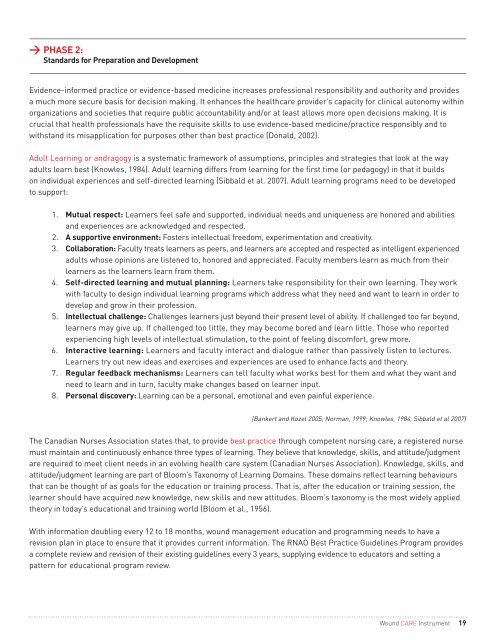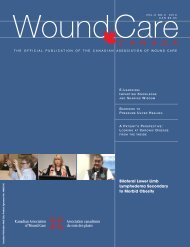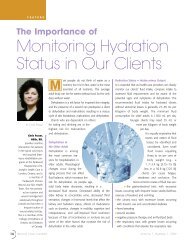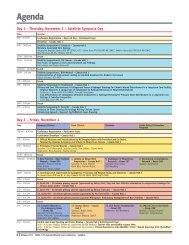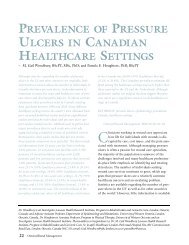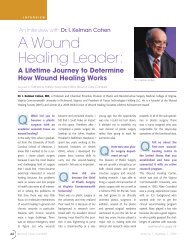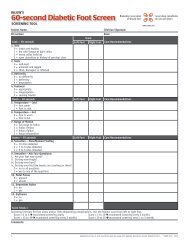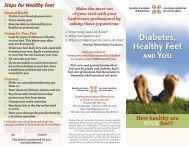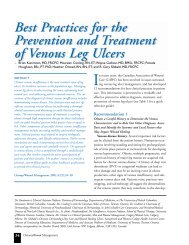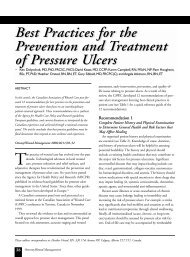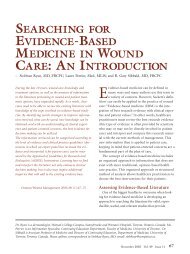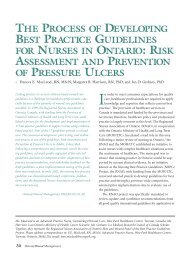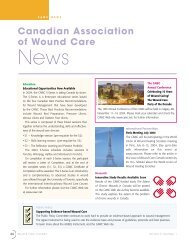Wound Care Instrument - Canadian Association of Wound Care
Wound Care Instrument - Canadian Association of Wound Care
Wound Care Instrument - Canadian Association of Wound Care
You also want an ePaper? Increase the reach of your titles
YUMPU automatically turns print PDFs into web optimized ePapers that Google loves.
phase 2:<br />
standards for preparation and Development<br />
Evidence-informed practice or evidence-based medicine increases pr<strong>of</strong>essional responsibility and authority and provides<br />
a much more secure basis for decision making. It enhances the healthcare provider’s capacity for clinical autonomy within<br />
organizations and societies that require public accountability and/or at least allows more open decisions making. It is<br />
crucial that health pr<strong>of</strong>essionals have the requisite skills to use evidence-based medicine/practice responsibly and to<br />
withstand its misapplication for purposes other than best practice (Donald, 2002).<br />
Adult Learning or andragogy is a systematic framework <strong>of</strong> assumptions, principles and strategies that look at the way<br />
adults learn best (Knowles, 1984). Adult learning differs from learning for the first time (or pedagogy) in that it builds<br />
on individual experiences and self-directed learning (Sibbald et al. 2007). Adult learning programs need to be developed<br />
to support:<br />
1. mutual respect: Learners feel safe and supported, individual needs and uniqueness are honored and abilities<br />
and experiences are acknowledged and respected.<br />
2. a supportive environment: Fosters intellectual freedom, experimentation and creativity.<br />
3. Collaboration: Faculty treats learners as peers, and learners are accepted and respected as intelligent experienced<br />
adults whose opinions are listened to, honored and appreciated. Faculty members learn as much from their<br />
learners as the learners learn from them.<br />
4. self-directed learning and mutual planning: Learners take responsibility for their own learning. They work<br />
with faculty to design individual learning programs which address what they need and want to learn in order to<br />
develop and grow in their pr<strong>of</strong>ession.<br />
5. intellectual challenge: Challenges learners just beyond their present level <strong>of</strong> ability. If challenged too far beyond,<br />
learners may give up. If challenged too little, they may become bored and learn little. Those who reported<br />
experiencing high levels <strong>of</strong> intellectual stimulation, to the point <strong>of</strong> feeling discomfort, grew more.<br />
6. interactive learning: Learners and faculty interact and dialogue rather than passively listen to lectures.<br />
Learners try out new ideas and exercises and experiences are used to enhance facts and theory.<br />
7. regular feedback mechanisms: Learners can tell faculty what works best for them and what they want and<br />
need to learn and in turn, faculty make changes based on learner input.<br />
8. personal discovery: Learning can be a personal, emotional and even painful experience.<br />
(Bankert and Kozel 2005; Norman, 1999; Knowles, 1984, Sibbald et al 2007)<br />
The <strong>Canadian</strong> Nurses <strong>Association</strong> states that, to provide best practice through competent nursing care, a registered nurse<br />
must maintain and continuously enhance three types <strong>of</strong> learning. They believe that knowledge, skills, and attitude/judgment<br />
are required to meet client needs in an evolving health care system (<strong>Canadian</strong> Nurses <strong>Association</strong>). Knowledge, skills, and<br />
attitude/judgment learning are part <strong>of</strong> Bloom’s Taxonomy <strong>of</strong> Learning Domains. These domains reflect learning behaviours<br />
that can be thought <strong>of</strong> as goals for the education or training process. That is, after the education or training session, the<br />
learner should have acquired new knowledge, new skills and new attitudes. Bloom’s taxonomy is the most widely applied<br />
theory in today’s educational and training world (Bloom et al., 1956).<br />
With information doubling every 12 to 18 months, wound management education and programming needs to have a<br />
revision plan in place to ensure that it provides current information. The RNAO Best Practice Guidelines Program provides<br />
a complete review and revision <strong>of</strong> their existing guidelines every 3 years, supplying evidence to educators and setting a<br />
pattern for educational program review.<br />
<strong>Wound</strong> CARE <strong>Instrument</strong> 19


